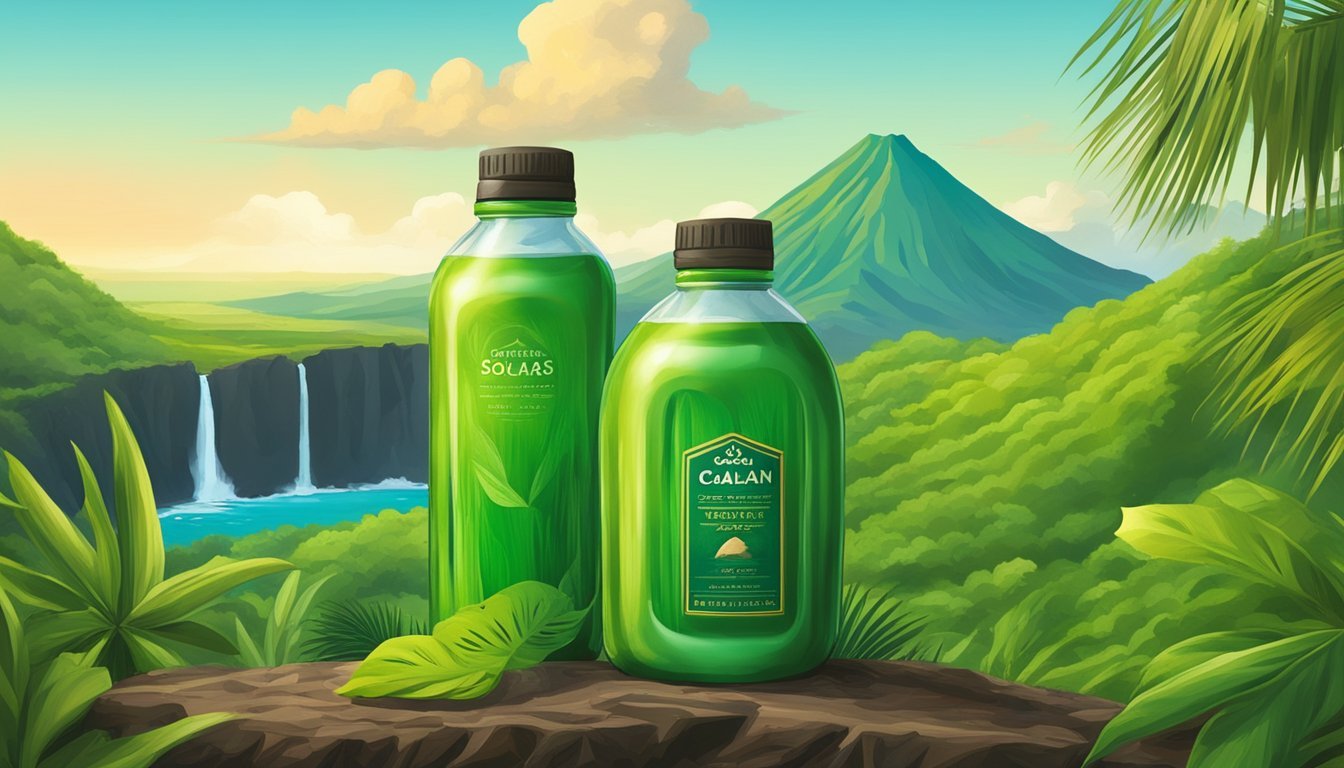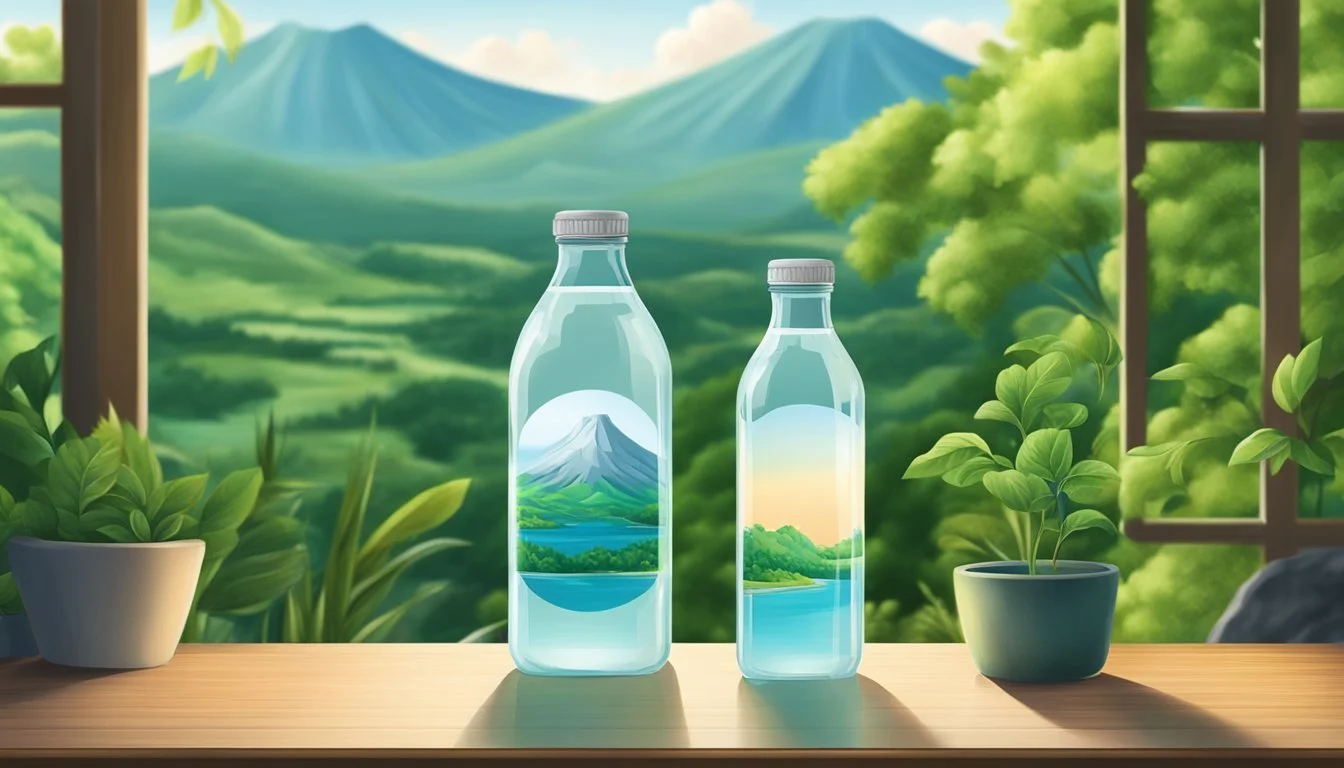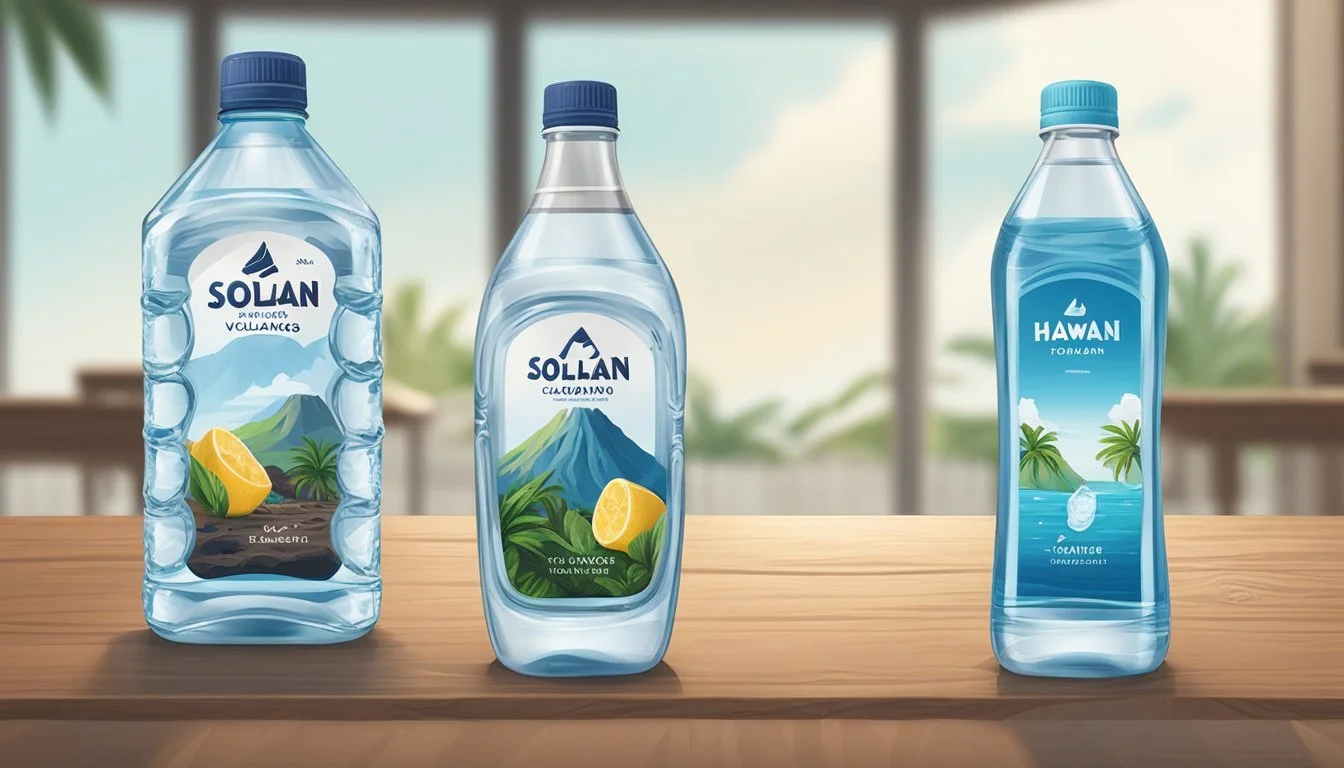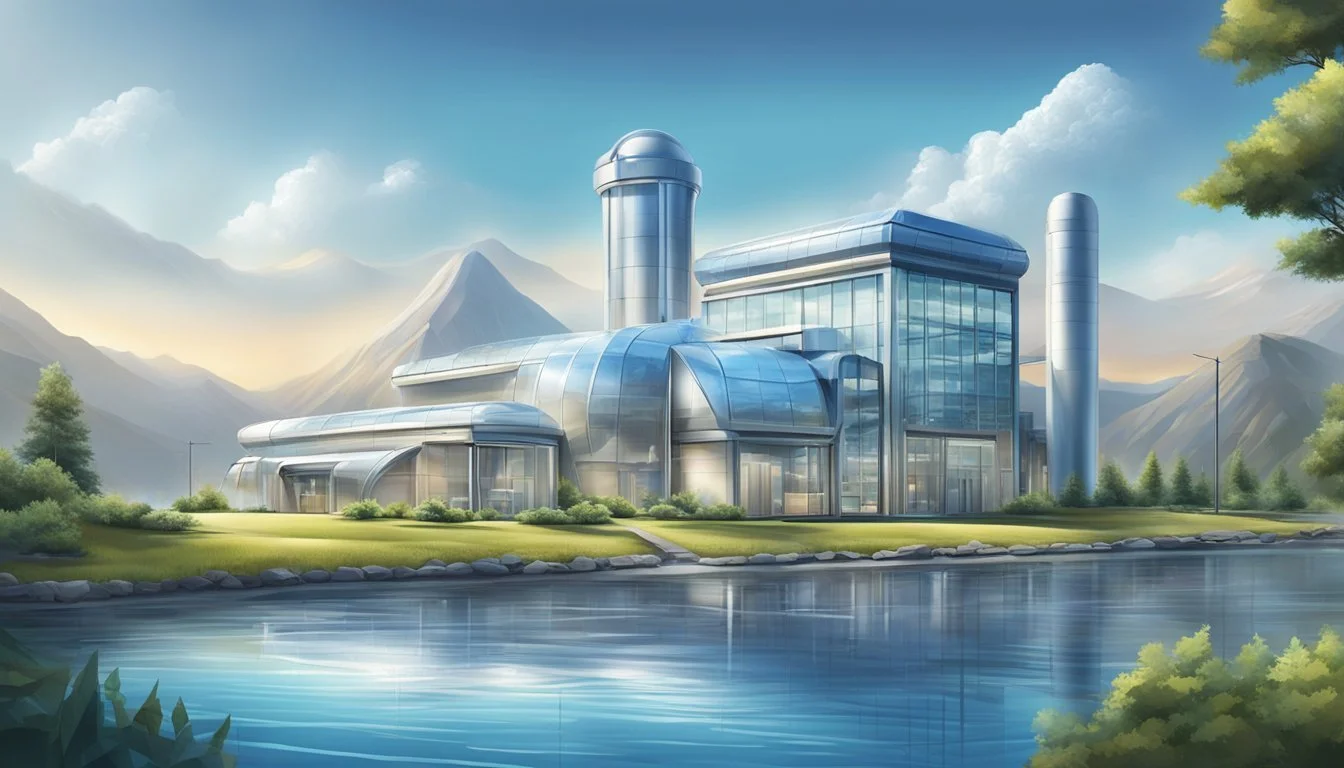Solán de Cabras vs. Hawai’i Volcanic
Comparing Premium Bottled Waters
Choosing between bottled waters can be a nuanced affair, especially when comparing premium brands like Solán de Cabras and Hawai’i Volcanic. Each brand offers distinct features influenced by their unique sources and mineral compositions. While Solán de Cabras boasts a rich heritage from the Serranía de Cuenca in Spain and is celebrated for its pristine mineral profile, Hawai’i Volcanic attracts consumers with its refreshing taste derived from volcanic filtration, rich in electrolytes.
For those seeking a more mineral-rich and historically revered option, Solán de Cabras stands out with its legacy spanning over 3,600 years. Its natural mineral content contributes to a distinctive taste that many appreciate for its supposed health benefits. Originating from a region with a history of being healed by this water, it maintains a reputation for purity and tradition.
Conversely, Hawai’i Volcanic is notable for its crisp and clean flavor, which is enhanced by the volcanic processes unique to the Hawaiian Islands. With a focus on delivering a hydrating experience through its natural electrolytes, this water offers a contemporary and refreshing option. The contrast between tradition and modernity highlights the varied preferences among bottled water enthusiasts.
Understanding Bottled Water
Bottled water has grown significantly in popularity, driven by factors such as the promise of purity, enhanced quality standards, and convenience. This section examines the history, types, and quality measures of bottled water.
History and Emergence of Bottled Water
Bottled water's origins can be traced back to 1622 when the Holy Well bottling plant produced and sold water in England. The practice gained traction in Europe during the 18th and 19th centuries, often recognized for its health benefits.
In the United States, the commercialization of bottled water boomed in the late 20th century. Driven by advancements in bottling technology and increasing health consciousness, it quickly became a staple for hydration and convenience.
Types of Bottled Water
Bottled water is categorized into several types based on its source and treatment. Spring water comes from underground formations where water flows naturally to the surface. Mineral water contains specific mineral content that is beneficial, such as calcium and magnesium.
Purified water undergoes processes like distillation and reverse osmosis to remove impurities. Artesian water is sourced from confined aquifers. Sparkling water contains dissolved carbon dioxide, either naturally or artificially added, providing a fizzy texture.
Evaluating Quality and Purity Standards
Quality and purity are paramount in bottled water. Regulations by entities such as the FDA in the United States ensure compliance with safety and quality standards. Bottled water must meet specific criteria for microorganisms, chemicals, and radiological contaminants.
Purity also involves ensuring that bottled water is free from harmful pollutants. Many brands highlight their natural sourcing to stress purity. Consumers often look for certifications and laboratory test results verifying that the water meets rigorous standards.
Minerals such as calcium and magnesium are frequently added or preserved, contributing to the health benefits and taste profile of the water. High-quality brands often showcase detailed mineral content analysis, proving their commitment to quality and purity.
Profile of Solán de Cabras
Solán de Cabras stands out for its rich heritage, unique natural filtration process, and beneficial mineral content. Derived from the pristine Serranía de Cuenca mountains in Spain, it offers a sustainable and authentic choice in natural mineral water.
Origin and History
Solán de Cabras traces its origins back over 3,600 years to the Serranía de Cuenca in Spain. This premium natural mineral water is sourced from a spring that has been revered throughout history for its purity and purported healing properties.
Ancient thunderstorms in the region contributed to the formation of the spring. The brand emphasizes sustainability and maintains its historical ties to the local environment. Today, Solán de Cabras is recognized for its commitment to preserving the natural purity of its source.
Process of Natural Filtration
The natural filtration process of Solán de Cabras is a key aspect of its quality. Rainwater from another era infiltrates the earth and undergoes a process that takes millennia. This slow journey through mineral-rich strata ensures the water is naturally purified.
The spring is located 3,000 feet above sea level, providing an optimal environment for this extensive filtration. Each drop of Solán de Cabras water contains minerals absorbed through this process, resulting in a balanced and pure end product without the need for artificial treatment.
Mineral Content and Health Benefits
Solán de Cabras mineral water boasts a distinct composition of essential minerals. It contains bicarbonate, calcium, sodium, potassium, and magnesium. These minerals contribute to various health benefits.
The bicarbonate aids digestion, while calcium supports bone health. Sodium and potassium help regulate fluid balance and nerve function. Magnesium contributes to muscle function and the reduction of fatigue. The balanced mineral content of Solán de Cabras makes it a healthy hydration choice, maintaining its role as a reputable and beneficial natural mineral water.
Profile of Hawai’i Volcanic
Hawai’i Volcanic water stands out for its unique source, filtration process, and rich mineral content. Gathering from the Mauna Loa volcano, this water boasts natural volcanic filtration and a composition that sets it apart.
Regional Background and Volcanic Source
Hawai’i Volcanic water originates from the Mauna Loa volcano on the Big Island of Hawaii. Mauna Loa, known for being the largest volcano in the world, provides an ideal natural source for volcanic water.
This volcano's vast shield formation allows rain and snowmelt to flow down its sides, ensuring a continuous supply to the family-owned deep wells located along its slopes.
Volcanic Filtration and Mineral Composition
The water from Mauna Loa undergoes natural filtration through thousands of feet of porous volcanic rock. This process enriches the water with essential minerals and electrolytes.
Key minerals like silica support vital bodily functions such as collagen synthesis. The volcanic filtration also results in a naturally alkaline water, usually with a pH around 8.0, enhancing its smooth and palatable taste.
Unique Attributes and Hydration
Hawai’i Volcanic water's unique attributes lie in its mineral composition and volcanic origin. Rich in electrolytes, it offers a refreshing profile ideal for hydration. Its natural alkalinity helps to neutralize acidity in the body, making it both a healthy and flavorful choice.
Moreover, the water is often positioned in the premium segment but remains relatively accessible in price, appealing to a wide range of consumers seeking quality hydration.
Comparative Analysis
Solán de Cabras and Hawai’i Volcanic offer distinct characteristics worth considering, including taste, mineral content, pH balance, and environmental impact.
Taste and Water Sommelier Insights
Solán de Cabras is often praised for its smooth and crisp taste, attributed to its unique mineral composition. It delivers a balanced and refreshing experience, appreciated by sommeliers for its neutrality.
Hawai’i Volcanic has a slightly more robust taste, reflecting its volcanic origin. Sommeliers note a subtle hint of minerals, providing a slightly more complex flavor profile compared to Solán de Cabras. This bold yet smooth finish is ideal for discerning palates looking for something unique.
Mineral Composition Face-Off
Here's a comparison of the mineral content:
Component Solán de Cabras (mg/L) Hawai’i Volcanic (mg/L) Calcium 18 15 Magnesium 3 5 Potassium 1.2 1 Sodium 5.9 5 Silica 7 10 Bicarbonate 16 40 TDS (Total Dissolved Solids) 170 150
While both waters provide a solid array of essential minerals, Hawai’i Volcanic tends to have higher bicarbonate levels, adding to its unique taste profile.
pH Level and Alkalinity Comparison
Solán de Cabras has a pH level of around 7.4, making it slightly alkaline and suitable for maintaining pH balance in the body.
Hawai’i Volcanic averages a pH level of about 7.7 to 8.2, which is higher, indicating greater alkalinity. This high alkalinity is beneficial for those seeking to neutralize acidity in their diet and promote general health.
Environmental Impact and Sustainability
Solán de Cabras demonstrates strong commitment to sustainability. The brand employs eco-friendly packaging and has implemented measures to minimize its carbon footprint. They also source water responsibly to protect the integrity of their natural springs.
Hawai’i Volcanic also emphasizes sustainability. They utilize recyclable materials and aim for carbon neutrality. They engage in conservation efforts to ensure the longevity of their volcanic water sources. Both brands make significant efforts, but their approaches and initiatives differ slightly.
Considerations for Consumers
When choosing between Solán de Cabras and Hawai’i Volcanic bottled water, consumers should look at the health benefits from electrolytes and minerals, the environmental impact of the packaging, and the availability of these brands in the market.
Health Impact of Electrolytes and Minerals
Solán de Cabras is known for its unique mineral composition, being filtered through centuries-old volcanic rock. This natural filtration process enriches the water with minerals such as calcium, magnesium, and potassium, which are essential for hydration and overall health.
Hawai’i Volcanic also boasts a rich mineral profile, including high levels of silica, which is beneficial for skin, hair, and nails. Both brands provide essential electrolytes that aid in hydration and maintaining electrolyte balance.
Consumers should compare the specific mineral content and health benefits based on their individual needs. For instance, an athlete might prioritize potassium and magnesium for muscle function, while someone else might value calcium for bone health.
Environmental Considerations of Packaging
When considering packaging, Solán de Cabras comes in recyclable glass bottles, which have a lower environmental footprint compared to plastic. Glass is inert, meaning it does not leach any chemicals into the water, maintaining purity.
Hawai’i Volcanic offers plastic bottles, including those made from 100% RPET (recycled plastic), which significantly reduces waste and promotes a circular economy. While plastic bottles are more common, they can be less environmentally friendly if not properly recycled.
Consumers who are environmentally conscious might prefer Solán de Cabras for its glass bottles or Hawai’i Volcanic for its commitment to using RPET. Understanding the environmental impact helps in making a sustainable choice.
Accessibility and Availability in Markets
Accessibility is another critical factor for consumers. Solán de Cabras is widely available in European markets and selected gourmet grocery stores around the world. Its historical reputation and high-quality standards make it a premium choice.
Hawai’i Volcanic, on the other hand, is primarily marketed in the United States, especially in regions like Hawai’i and California. This brand leverages its local Hawaiian heritage to appeal to a specific market demographic.
Consumers should consider the ease of purchasing these brands based on their location. Availability in nearby stores or online options can influence the decision, ensuring that they can consistently access their preferred brand.
The Future of Bottled Water
The future of bottled water is poised to be shaped by evolving consumer preferences, significant innovations in sustainability and filtration, and their subsequent impacts on the market. Major brands are expected to lead the way in addressing these key areas.
Emerging Trends in Consumer Preferences
Consumers are increasingly prioritizing health-conscious and eco-friendly options. They seek out water that not only tastes good but also offers added health benefits, such as infused minerals or enhanced filtration. Premium brands, like Solán de Cabras and Hawai’i Volcanic, can capitalize on this focus by emphasizing their natural sources and unique qualities.
*Packaging Choices are also crucial; many prefer recyclable materials such as glass and aluminum cans over plastic. This trend pushes companies to innovate in ways that emphasize both sustainability and consumer desire.
Innovations in Sustainability and Filtration
Sustainability Practices are a significant focus for bottled water companies. Brands are investing in more sustainable packaging solutions to reduce environmental impacts.
Efforts include:
Using biodegradable bottles
Adopting aluminum cans
Ensuring recyclable packaging
In filtration technology, advancements are aimed at providing higher purity levels without compromising the mineral content which many consumers value. Technologies such as multi-stage filtration and reverse osmosis are becoming more widespread.
Implications for the Bottled Water Market
These trends and innovations will heavily influence the market trends. More brands, both premium and standard, will adopt eco-friendly measures to remain competitive. Sustainable practices may increase production costs initially, but they can lead to long-term savings through efficiencies.
Brand loyalty might shift towards those prioritizing both health benefits and conservation efforts. As the market responds, bottled water companies that quickly adapt to consumer demands and innovate responsibly will thrive in this evolving landscape.
Conclusion
Both Solán de Cabras and Hawai’i Volcanic offer distinct qualities that appeal to different preferences.
Solán de Cabras is renowned for its rich heritage, pristine spring source from the Serranía de Cuenca Mountains in Spain, and unique mineral composition. This water has been cherished for over 3,600 years and is reputed for its healing properties, making it a favored choice among those who appreciate history and tradition.
Hawai'i Volcanic, on the other hand, stands out for its sustainable practices and purity. This brand has garnered notable awards for its exceptional taste and mineral profile. It is collected from a natural environment in Hawaii, ensuring a clean and refreshing experience.
Final Recommendations:
For those who value heritage and mineral composition, Solán de Cabras is a superior choice.
Those who prioritize sustainability and purity might prefer Hawai'i Volcanic.
Both brands provide high-quality bottled water, catering to different tastes and values. Each maintains a commitment to delivering pure and refreshing hydration, ensuring consumers can select based on their specific preferences and needs.
Ultimately, the decision between Solán de Cabras and Hawai’i Volcanic will depend on individual priorities, whether leaning towards a storied legacy or modern sustainability.
More About Solan de Cabras
More About Hawai’i Volcanic
Acqua Pana vs Hawaii Volcanic: Which Bottled Water is Better?
Antipodes vs Hawaii Volcanic: Which Bottled Water is Better?
Aqua Carpatica vs Hawaii Volcanic: Which Bottled Water is Better?
Arrowhead vs Hawaii Volcanic: Which Bottled Water is Better?
Boxed Water vs Hawaii Volcanic: Which Bottled Water is Better?
Castle Rock vs Hawaii Volcanic: Which Bottled Water is Better?
Core Hydration vs Hawaii Volcanic: Which Bottled Water is Better?
Deer Park vs Hawaii Volcanic: Which Bottled Water is Better?
Hawaii Volcanic vs 1907water: Which Bottled Water is Better?
Hawaii Volcanic vs Alkaline88: Which Bottled Water is Better?
Hawaii Volcanic vs Big Chill: Which Bottled Water is Better?
Hawaii Volcanic vs BodyArmor: Which Bottled Water is Better?
Hawaii Volcanic vs Cascade Mountain: Which Bottled Water is Better?
Hawaii Volcanic vs CBD Living: Which Bottled Water is Better?
Hawaii Volcanic vs Crystal Geyser: Which Bottled Water is Better?
Hawaii Volcanic vs Crystal Lake: Which Bottled Water is Better?
Hawaii Volcanic vs Essence pH10: Which Bottled Water is Better?
Hawaii Volcanic vs Kirkland Signature: Which Bottled Water is Better?
Hawaii Volcanic vs Liquid Death: Which Bottled Water is Better?
Hawaii Volcanic vs Open Water: Which Bottled Water is Better?
Hawaii Volcanic vs Proud Source: Which Bottled Water is Better?
Hawaii Volcanic vs Pure Life: Which Bottled Water is Better?
Hawaii Volcanic vs Purely Sedona: Which Bottled Water is Better?
Hawaii Volcanic vs Richard's Rainwater: Which Bottled Water is Better?
Hawaii Volcanic vs Simple Truth: Which Bottled Water is Better?
Hawaii Volcanic vs Talking Rain AQA: Which Bottled Water is Better?
Hawaii Volcanic vs Weird Water: Which Bottled Water is Better?
Hawaii Volcanic vs Whole Foods 365: Which Bottled Water is Better?
Hawaii Volcanic vs Whole Foods Italian Still Mineral water: Which Bottled Water is Better?
Hawaiian Springs vs Hawaii Volcanic: Which Bottled Water is Better?
Ice Mountain vs Hawaii Volcanic: Which Bottled Water is Better?
Icelandic Glacial vs Hawaii Volcanic: Which Bottled Water is Better?
Just Water vs Hawaii Volcanic: Which Bottled Water is Better?
Mountain Valley Spring Water vs Hawaii Volcanic: Which Bottled Water is Better?
Nestle Pure Life vs Hawaii Volcanic: Which Bottled Water is Better?
Poland Spring vs Hawaii Volcanic: Which Bottled Water is Better?
San Pellegrino vs Hawaii Volcanic: Which Bottled Water is Better?
Smartwater vs Hawaii Volcanic: Which Bottled Water is Better?
Topo Chico vs Hawaii Volcanic: Which Bottled Water is Better?
Zephyrhills vs Hawaii Volcanic: Which Bottled Water is Better?









